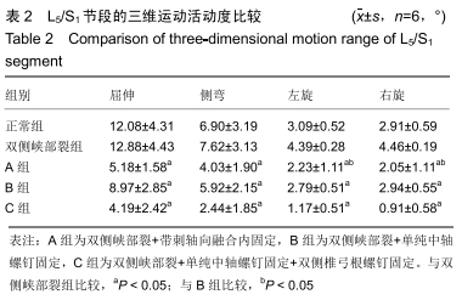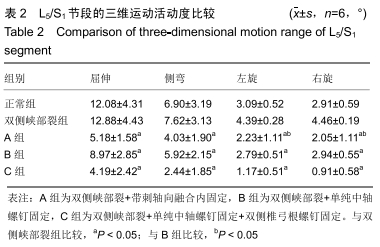[1] DERMAN PB, ALBERT TJ. Interbody fusion techniques in the surgical management of degenerative lumbar spondylolisthesis. Curr Rev Musculoskelet Med. 2017;10(4): 530-538.
[2] 孙芝城,王锡阳.退行性腰椎滑脱微创融合手术进展[J].中国微创外科杂志, 2019,19(5):445-448.
[3] 丁一,潘爱星,张扬璞,等.后入路腰椎单侧或双侧椎弓根螺钉内固定术联合椎间融合术治疗腰椎退行性疾病研究进展[J].中国骨与关节杂志,2019,8(2):141-144.
[4] 邓旭东.微创椎弓根螺钉内固定联合骶前间隙轴向融合治疗L5椎体滑脱症的临床观察[J].创伤外科杂志,2016,18(8):461-465.
[5] 欧阳智华,阙伊辰,宋西正,等.轴向融合联合经皮螺钉治疗轻中度腰5椎体滑脱症的临床观察[J].中南医学科学杂志,2017,45(3): 226-229+233+212.
[6] CRAGG A, CARL A,CASTENEDA F,et al. New Percutaneous access method for minimally invasive anterior lumbosacral surgery. Spinal Disord Tech. 2004;17(1):21-28.
[7] ZEILSTRA DJ, STAARTJES VE, SCHRÖDER ML. Minimally invasive transaxial lumbosacral interbody fusion: a ten year single-centre experience. Int Orthop.2017;41(1):113-119.
[8] 舒小林,宋西正.AxiaLIF在腰骶椎融合治疗中的应用[J].中国组织工程研究,2018,22(3):456-463.
[9] ANAND N, ALAYAN A, COHEN J, et al. Clinical and radiologic fate of the lumbosacral junction after anterior lumbar interbody fusion versus axial lumbar interbody fusion at the bottom of a long construct in cmis treatment of adult spinal deformity. J Am Acad Orthop Surg Glob Res Rev. 2018;2(10): e067.
[10] 韩华,韩佳栩,项燕,等.腰骶段脊柱前方大血管的解剖学研究[J].局解手术学杂志,2019,28(2):91-95.
[11] 曾德辉,张卫,张彬,等.设计国人直肠后间隙入路轴向腰骶椎融合内固定的影像学测量[J].中国组织工程研究,2017,21(27): 4373-4378.
[12] 杜传超,张衡,海宝,等.脊柱阶段性解剖特点及其损伤的力学机制与诊疗策略[J].创伤外科杂志,2019,21(7):552-557.
[13] HOFSTETTER CP, SHIN B, TSIOURIS AJ, et al. RadiograPhic and clinicaloutcome after 1- and 2-level transsacral axial interbody fusion. J Neurosurg Spine. 2013; 9(4):454-463.
[14] PATIL SS, LINDLEY EM, PATEL VV, et al. Clinical and radiological out-omes of axial lumbar interbody fusion. Orthopedics. 2010;33(12):883.
[15] SILVESTRE C, MAC-THIONG JM, HILMI R, et al. Complications and morbidities of mini-open anterior retroperitoneal lumbar interbody fusion: oblique lumbar interbody fusion in 179 patients. Asian Spine J. 2012,6(2): 89-97.
[16] NOTTMEIER EW, PIRRIS SM. Placement of thoracic transvertebral Pedicle screws using 3D image guidance. J Neurosurg Spine. 2013;18(5):479-483.
[17] ERKAN S,WU C,MEHBOD AA,et al. Biomechanical evaluation of a new AxiaLIF technique for two-level lumbar fusion. Eur Spine J.2009;18(6):807-814.
[18] ÖZALP H, ÖZKAYA M, YAMAN O, et al. Biomechanical comparison of transdiscal fixation and Posterior fixation with and without transforaminal lumbar interbody fusion in the treatment of L5-S1 lumbosacral joint. Proc Inst Mech Eng H. 2018;232(4): 371-377.
[19] DICKMAN CA, FESSLER RG, MACMILLAN M, et al. TransPedicular screw-rod fixation of the lumbar spine: oPerative technique and outcome in104 cases. J Neurosurg. 1992;77: 860-870.
[20] 王华锋,郑召民.经骶前间隙轴向腰椎间融合术的研究进展[J].中国脊柱脊髓杂志,2013,23(3):275-278.
[21] 宋西正,王文军,薛静波,等.经骶前间隙轴向椎间融合联合内窥镜下后入路椎间盘摘除治疗腰骶椎退行性疾病[J].中国脊柱脊髓杂志, 2013,23(9):778-782.
[22] SINGHATANADGIGE W, KANG DG, WIRANUWAT D, et al. Awareness of middle sacral artery pathway: A cadaveric study of the presacral area. J Orthop Surg (Hong Kong). 2018;26(1): 94-99.
[23] DERMAN PB, ALBERT TJ. Interbody fusion techniques in the surgical management of degenerative lumbar spondylolisthesis. Curr Rev Musculoskelet Med. 2017;10(4): 530-538.
[24] SCHROEDER GD, KEPLER CK, VACCARO AR. Axial interbody arthrodesis of the L5-S1 segment: a systematic review of the literature. J Neurosurg Spine. 2015;23(3): 314-319.
[25] GROB D, DVORAK J, PANJABI M, et al. Posterior occiPitocervical fusion: a preliminary report of a new technique. Spine. 1991;16(3 SuPPl):S17-24.
[26] HENRIQUES T, CUNNINGHAM BW, OLERUD C, et al. Biomechanical comparison of five different atlantoaxial posterior fixation techniques. Spine. 2000;25(22): 2877-2883.
[27] AGHAYEV K, GONZALEZ-BLOHM SA, DOULGERIS JJ, et al. Feasibility and biomechanical performance of a novel transdiscal screw system for one level in non-sPondylolisthetic lumbar fusion: an in vitro investigation. Spine J. 2014;14(4):705-713.
[28] BOACHIE-ADJEI O, CHO W, KING AB. Axial lumbar interbody fusion (AxiaLIF) approach for adult scoliosis. Eur SPine J. 2012; 22(2):S225-231.
[29] 刘栋梁. 腰骶椎带刺内锁轴向融合内固定的有限元分析[D].衡阳:南华大学,2017.
|



